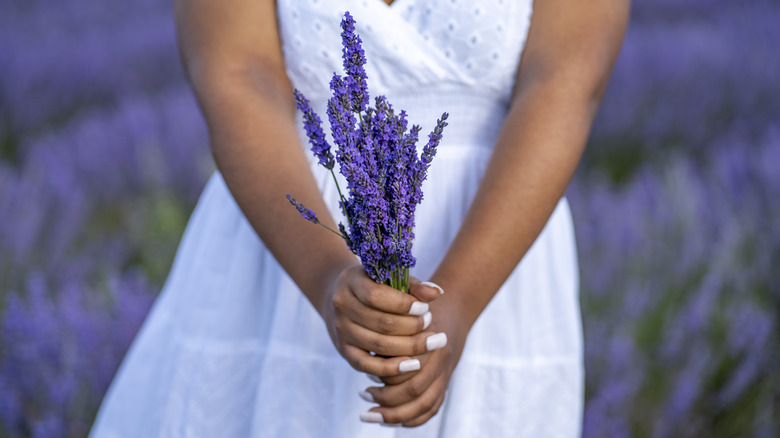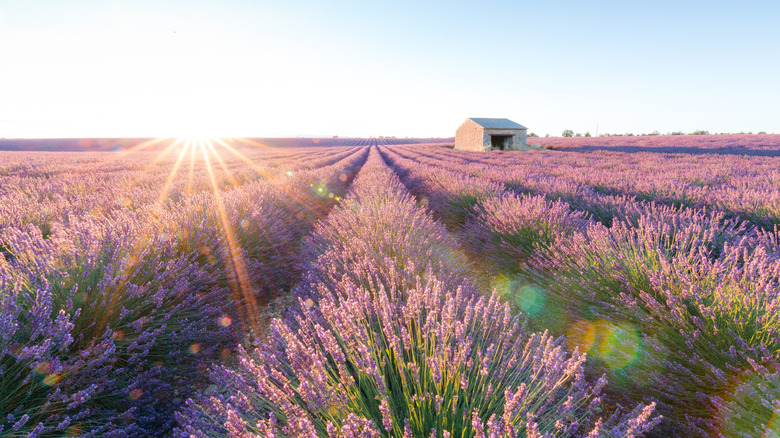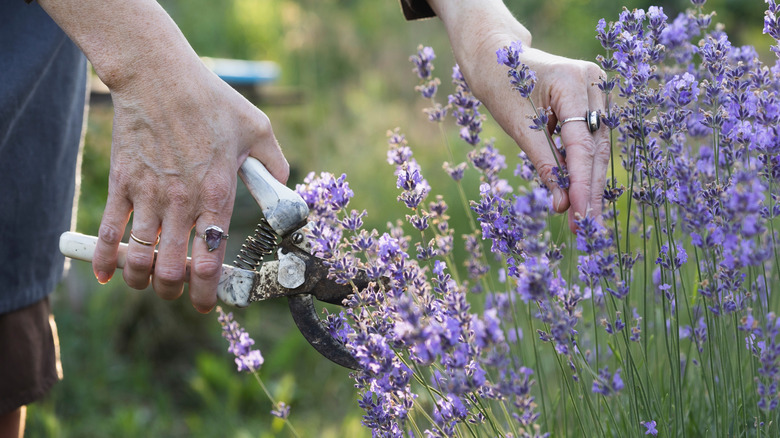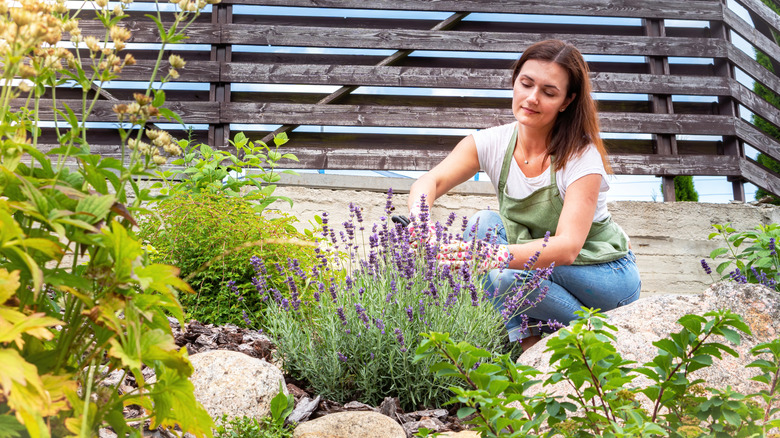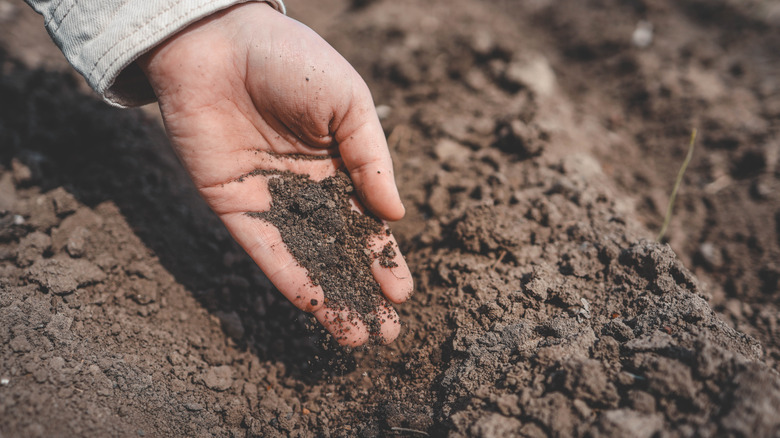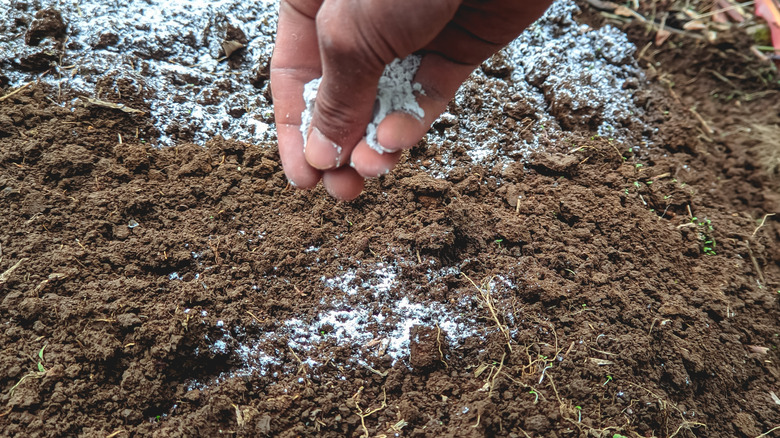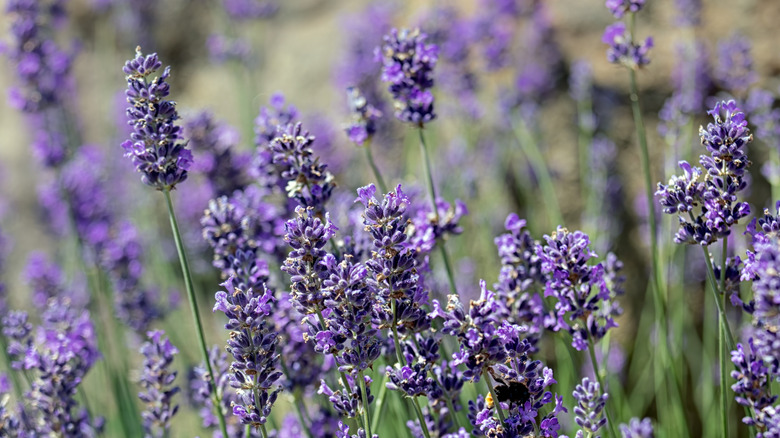8 Foolproof Ways To Encourage More Blooms On Your Lavender Plants
Lavender (Lavandula spp.) is a beloved herb known for its fragrant blooms, attractive silvery foliage, and low-maintenance profile. Thriving in U.S. Department of Agriculture plant hardiness zones 5a through 9b, this Mediterranean native is an ideal choice for gardeners seeking both beauty and possible health benefits. The Cleveland Clinic reports that lavender can be effective in everything from supporting a better night's sleep to creating a sense of calm in your environment. Additionally, this plant's striking purple blossoms are not only visually appealing, but also serve as a magnet for beneficial pollinators like bees and butterflies, while simultaneously deterring pests such as houseflies, snakes, and mealybugs. Whether you're planting a border, filling a rock garden, or simply adding a splash of color and a pleasant scent near walkways or patios, lavender is an excellent choice.
To encourage your lavender to produce the most abundant, vibrant blooms, there are a few foolproof tips that you can utilize. For example, adding gravel to compacted soil will improve drainage, empowering flowers to bloom more fully. Allowing the soil to dry out between waterings is also a must, as lavender is drought-tolerant and dislikes soggy roots. Keeping the planting area free from weeds is another way to encourage blooms, as weeds rob lavender of important nutrients. While proper care can certainly boost blooming, it's important for gardeners to keep in mind that lavender typically takes one to three years to mature fully. During this time, you won't see your plants reach their full potential. With a little time and attention, however, your lavender will reward you with a plethora of fragrant flowers season after season.
Amend the soil with gravel
If your lavender plants are growing but failing to produce desirable blooms, compacted or poorly draining soil may be the culprit. Lavender is naturally drought-tolerant and thrives in dry, airy conditions, which means it doesn't tolerate moist environments well. When lavender is planted in heavy or compacted soil, excess water tends to linger around the roots. This trapped moisture can smother the root system, which may lead to root rot. This disease hinders the plant from taking in important nutrients. As the roots deteriorate, the plant loses the ability to support healthy flower growth, often resulting in blooms that wilt, drop early, or never fully develop.
To encourage more blooms on your lavender plant, it's essential to improve soil drainage by amending it with gravel. Mixing in coarse gravel at a ratio of 30% gravel to 70% soil creates a looser, more breathable medium that allows water to drain quickly, so lavender roots are able to avoid being waterlogged and stay oxygenated. This adjustment not only prevents root rot, but also encourages deeper root development, which supports stronger, more productive flowering stems. By replicating the well-draining, rocky conditions of lavender's native Mediterranean habitat, gardeners can help their plants spend their energy on blooming instead of battling stress caused by excess moisture.
Increase sun exposure
Inadequate sunlight is another common factor in otherwise healthy lavender plants not producing many blooms. Lavender can survive in partial sun, but it won't bloom as profusely if it receives fewer than six hours of direct sunlight per day. This is especially important to note in cloudy climates, shaded garden beds, or indoor rooms that don't have much artificial light. Without sufficient sunlight, the plant cannot photosynthesize effectively, which limits its energy reserves and redirects growth toward foliage instead of flowers. Thankfully, you simply need to increase your plant's daily exposure to direct sun or, if indoors, supplement with 14 to 16 hours of full-spectrum LED lighting to mimic natural daylight to fix the problem.
Maximizing sunlight exposure is the best way to support the plant's ability to bloom. Lavender is native to Mediterranean regions that experience longer periods of sunlight. Receiving more than 6 hours of sunlight per day allows for maximum energy production through photosynthesis, as this is what the plant's biology is designed to absorb. Naturally, that results in flowers that are fuller and more colorful than they would be in conditions with less-than-ideal lighting.
Prune lavender only once per year in the spring
If your lavender is growing well, but producing few or no blooms, take a look at your pruning practices. Many gardeners make mistakes when pruning lavender, such as doing so too frequently or at the wrong time of year. This is especially true in the fall or winter when the plant is preparing to go dormant. Pruning during these colder months can damage new growth and reduce flower production for the following season. The solution is to prune just once a year in the spring after new green growth appears, but before the plant sets buds. This timing helps shape the plant without interfering with the upcoming bloom cycle.
Spring pruning stimulates healthy new growth and encourages the lavender plant to direct its energy toward flower development, rather than maintaining woody stems that won't produce the results you're looking for. By cutting back about one-third of the plant in spring, you remove dead material from the previous season and promote a fuller, more compact shape that offers better airflow, as well as the ability to receive more sunlight. This practice not only helps prevent disease, but also gives you the more prolific blooms you seek. Add this chore to your calendar each spring and you're sure to continue enjoying a healthy and abundant lavender harvest for many years to come.
Deadhead fading flowers to encourage repeat blooms
Even if your lavender is pruned correctly in the spring, it may stop blooming mid-season if fading flowers are left on the plant. Unlike annual pruning, which is best completed just once per year to keep lavender healthy and properly shaped, deadheading may be required several times throughout the growing season. The best time to deadhead lavender is right when you notice the blooms begin to fade. When spent flowers are allowed to remain on the plant, energy that could be used to create attractive new blooms is wasted on seed production. The result is an average yield that never got a chance to reach its full potential.
Removing fading flower spikes encourages the plant to redirect its energy into producing another round of blossoms. Deadheading should be practiced on all varieties of lavender, as well as those grown in pots or in the ground. As soon as you spot a flower that has begun to fade, snip it off using a clean set of pruning shears. Locate the last set of leaves below the spent flower and make your cut there. Repeat as needed and you'll find the result of incorporating this maintenance task into your routine is a longer-lasting crop that is not only more vibrant in color, but also more fragrant as well.
Feed lavender with compost not fertilizer
If your lavender is producing plenty of leaves but the flowers are lacking, the problem may be overfeeding. This is especially true if you're using a synthetic fertilizer. Oftentimes gardeners assume that more nutrients will lead to more blooms, but when it comes to lavender, the opposite is actually true. High-nitrogen fertilizers can cause an overgrowth of soft, leafy foliage at the expense of flower production, reports Epic Gardening. This is because excessive nitrogen shifts the plant's energy away from blooming, resulting in lush greenery with sparse or missing blooms. Fortunately, the fix is quite simple. Toss the commercial fertilizer and apply a light topdressing of aged compost once a year to support the plant's needs, as this won't overstimulate leaf growth.
Aged compost is best, as it provides a slow-release, balanced source of nutrients that lavender plants benefit from. Compost is natural and known for its ability to improve soil structure and support microbial activity without all the extra nitrogen that you find in synthetic fertilizers. If your soil is particularly deficient, you can also supplement lightly with a few other natural amendments, such as bone meal, blood meal, or kelp, which help adjust nutrient levels more gently than their chemical counterparts.
Note: In the event that you're growing your lavender in pots, Illinois State University Extension recommends making sure the potting soil you're using isn't infused with fertilizer.
Allow the soil to dry out in between waterings
Overwatering is another issue that may be the cause of your lavender underperforming. Remember, lavender is highly drought-tolerant and adapted to dry, rocky conditions, so, naturally, it will struggle in consistently moist or soggy soil, which is in stark contrast to its native environment. Too much water can actually lead to yellowing leaves, root rot, crown rot and even lifeless foliage. This happens as the plant is unable to take in proper nutrients due to its waterlogged roots. With disease and the lack of proper nutrients, lavender blooms suffer. To correct this issue, home gardeners must allow the soil to dry out to a depth of at least 6 inches between waterings. You can test soil dryness by sticking your finger down into the soil surrounding the herb. If your finger is wet, skip the watering. A dry finger means it's time to get out the watering can. Additionally, there are a few spots you want to avoid when planting lavender. These include near low spots, under roof downspouts, or other areas where water tends to collect.
Proper moisture management supports strong flowering by preserving the dry root environment lavender needs to thrive. When soil is allowed to dry out, oxygen can reach the roots and nutrients are best able to be absorbed. This allows for more robust growth and a fuller crop. It's recommended to use drip irrigation, rather than overhead watering, to reduce moisture on the foliage and keep the soil from becoming oversaturated. This method delivers water directly to the base of the plant in a controlled way that is more like the natural conditions lavender experiences in its native land. By maintaining a careful watering routine and prioritizing drainage, you'll help your lavender focus its energy on blooming rather than recovering from water stress.
Adjust soil pH if necessary
Lavender that is healthy, but producing few or lackluster blooms, may actually be planted in soil that isn't the ideal pH for the plant. Lavender prefers slightly alkaline to neutral soil, ideally between 6.5 and 7.0. When the pH falls below this range, it becomes too acidic and hinders flower growth by altering the nutrients available to the plant, as well as the number of good bacteria typically found in the soil. Poor bloom performance is often tied to soil that falls outside the optimal pH range. To fix imbalances in soil acidity, test your soil and, if needed, amend it with dolomite lime, a natural additive that gently raises pH over time, while also providing beneficial minerals.
Correcting the pH balance to match the natural requirements of lavender allows the plant to more efficiently absorb the nutrients it needs to produce strong stems and abundant flowers. This way the plant isn't wasting energy fighting toxic ingredients that are often found in acidic soils, such as aluminum, but instead is using that energy to properly feed and support the lavender, which naturally results in more attractive blooms. By fine-tuning the pH, you're creating the ideal conditions for vibrant, fragrant lavender blossoms to thrive.
Pick the right variety of lavender
Sometimes, the reason lavender isn't blooming as expected comes down to choosing the wrong variety for your growing conditions and goals. Not all lavender plants produce the same number of flowers or grow with the same structure. Some types are more compact and better suited for containers, while others grow bushier and produce fuller flushes of blooms. English varieties like 'Munstead' and 'Hidcote' are prized for their tidy, mounded shapes and prolific flowering in cooler climates. For gardeners in warmer or more humid areas, 'Phenomenal' offers excellent bloom production along with disease resistance. And if you're after long stems and heavy flower output, 'Provence', is an excellent choice, especially if you're considering a mass planting.
Choosing a variety known for its dense growth and high bloom yield ensures you're starting with the right characteristics for success. Each of these popular cultivars are well-known and loved for their flower production. Matching your climate and soil to the variety's natural preferences allows the plant to focus its energy on flower production instead of merely just surviving. The result is a thriving crop that is sure to please onlookers for the duration of the growing season.
